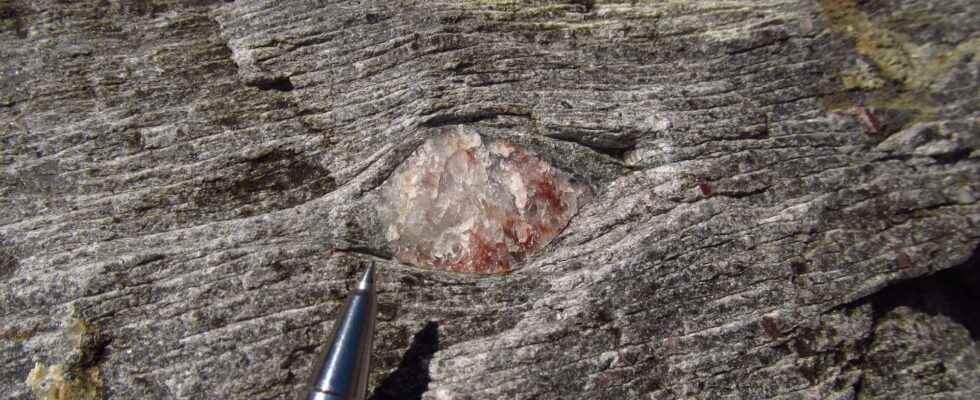Metamorphism is an essential process in geology. It represents all the transformations that a rock undergoes when it is subjected to an increase in pressure and / or temperature.
The rocks we observe seem to us solid and sustainable. In reality, they are only stable in well-defined domains of pressure and temperature (PT). If these conditions change, rocks and minerals transform according to a process called metamorphism. This transformation is very different from the fusion, which represents a change of state. In the case of metamorphism, the modifications take place in the solid state, within the minerals and the structure of the rock. These are mainly mineralogical recrystallizations.
The ingredients of metamorphism
There are different types of metamorphisms. Each is associated with variations in temperature, pressure, and / or a supply ofchemical elements. In general, whatever the context, if there is a sufficient increase in pressure and temperature, the metamorphic process kicks in. Thus, when an important amount of sediment accumulates in a pond, the layers at the base will undergo an increase in pressure and temperature in connection with the burial. This is the process of diagenesis, which is a low temperature metamorphic process. The sediments will thus be transformed into sedimentary rock.
However, the majority of metamorphic rocks observables are produced in connection with tectonic events affecting large regions: stacking of crustal units in an orogenic context (formation of a mountain range), subduction of an oceanic plate, collision between continental lithospheres. The rocks that get trapped by these movements tectonics will undergo enormous increases in pressure and temperature, inducing recrystallizations which will then take place under oriented stresses, imprinting in the metamorphosed rock deformations of the foliation, schistosity or lineation type.
However, the metamorphic process can also take place without any tectonic deformation or burial. This is the case with contact metamorphism, which occurs when a host rock is heated by the arrival of a nearby magmatic intrusion. The arrival of magma causes the temperature (but not the pressure) to rise, which will “anneal” without melting the surrounding rocks. Around the magmatic intrusion is therefore created a halo of metamorphism within which a zonation of transformations is observed, which in this case are mainly mineralogical rearrangements. We speak of contact metamorphism.
In a still different context, we can observe a metamorphic process at the level of the oceanic crust, in response to intense hydrothermal activity. Indeed, the oceanic crust, placed at the axis of the ridge, will fracture and allow sea water to penetrate. By circulating in depth within the crust, this water will heat up and change its chemical composition to become what is called a hydrothermal fluid. In contact with this fluid, the rocks will undergo transformations, in particular by the addition of chemical elements. The gabbros can thus turn into amphibolites then in shale green, while peridotites of coat will turn into serpentinite. We speak of hydrothermal metamorphism.
Finally, a last type of metamorphism is observed when there is a meteorite impact. The fall of a meteorite on the surface of the Earth causes shock and a sudden and phenomenal rise in pressure and temperature, which transforms the minerals in a very characteristic way. We then speak of impact metamorphism.
In general, the field of metamorphism extends over temperatures ranging from 50 ° / 100 ° C to 650/700 ° C.
Metamorphic reactions
When a rock enters pressure and temperature conditions which deviate too much from their formation conditions, the minerals unstable under these PT conditions will be replaced by stable minerals characteristic of these new conditions. New mineral can thus have the same chemical composition but a very different crystal structure. This is the case, for example, with Andalusite, kyanite and sillimanite, all of which have the same formula (Al2SiO5) but which are stable under different PT conditions. But there can also be reactions between several minerals. The pressure and temperature stability fields of the various minerals are shown in petrogenetic diagrams.
The study of metamorphic rocks provides information on the path taken by the original rock. We then speak of PTt (Pressure-Temperature-time) paths. Depending on its mineralogical composition, it is possible to know if the rock has undergone a large and rapid increase in pressure but a small increase in temperature, or the reverse, and if its return to the surface was rather rapid ( decrease in pressure and maintain a high temperature) or slow (slow decrease in temperature and pressure). These PTt paths are very useful for reconstructing the tectonic history of a region.
Some examples of metamorphic sequences
All types of rocks can undergo metamorphism. Thus, shales are the result of the metamorphism of an argillaceous rock. the marble is the result of the transformation of a limestone. the gneiss is a metamorphic rock resulting from the transformation of a rock rich in quartz, mica and feldspars, such as granites.
You will also be interested
Interested in what you just read?
.
fs12
